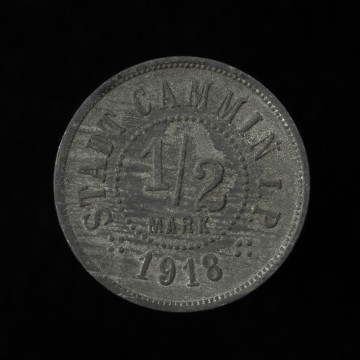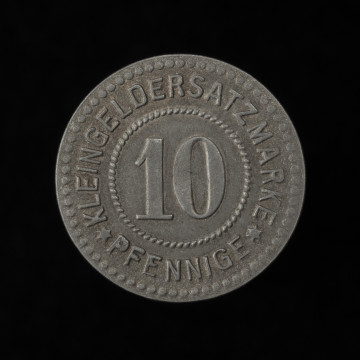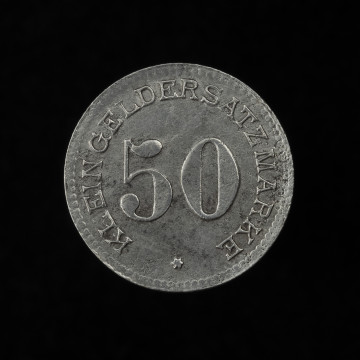
1/2 Mark (50 pfennig)
1918
National Museum in Szczecin
Part of the collection: Scrip
The snatching of small bullion coins out of circulation by the German population during the First World War, contemptuously referred to as hoarding by patriotically-minded individuals, led to difficulties in the retail trade. In order to mitigate the shortage of low denominations, which was a nuisance for the money trade, local authorities took initiative to issue their own currency. The idea was that the replacement money should preferably be metal coins, as the paper bills that had been issued previously did not work well in circulation. This mindset was also shared by the town magistrate in Kamień Pomorski. In 1918 and 1920, coins of 10 and 50 pfennig were issued, minted by the Wilhelm Mayer & Franz Wilhelm of Stuttgart. They were stamped in iron as well as in zinc. There are particularly many known varieties of 50 pfennig coins from 1918. One reason for this is the two existing denomination notation designs in circulation: ½ MARK (much rarer) and ½ Mk, the 1920 coin pictured here was given a different design. The fraction of the mark was replaced by the amount of pfennig it corresponded to, i.e. 50 with Pf. underneath, and the outer mother of pearl rim was replaced by border composed of arcs and dots. The new 50-pfennig coin was minted in two metals. However, it is believed that the iron 50 pfennigs, like the iron 10 pfennigs of 1920, did not make it into circulation. Perhaps these coins were produced for commercial purposes and were sold off to collectors. The experiments of the local government with metal replacement money were not successful. The production of the coins was costly and cumbersome and the growing replacement coins-collecting caused more coins to disappear from the money market in any case. Mieszko Pawłowski
Other names
50 Pfennig, Notgeld
Author / creator
Object type
token coin
Technique
coining
Material
zinc
Origin / acquisition method
purchase
Creation time / dating
Creation / finding place
Owner
Muzeum Narodowe w Szczecinie (1945- )
Identification number
Location / status

1918
National Museum in Szczecin

1918
National Museum in Szczecin

1901 — 1925
National Museum in Szczecin
DISCOVER this TOPIC
Museum of King Jan III's Palace at Wilanów
DISCOVER this PATH
Educational path